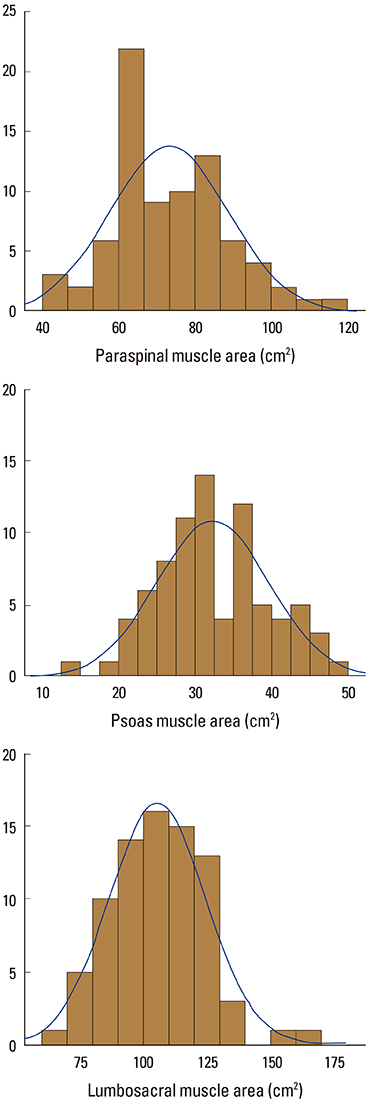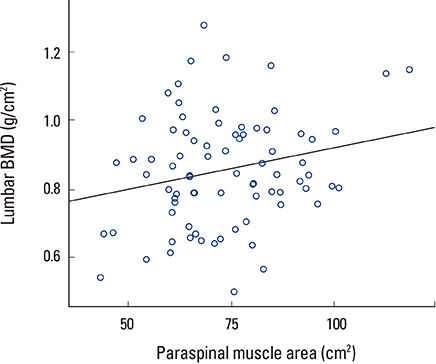J Bone Metab.
2015 Nov;22(4):197-204. 10.11005/jbm.2015.22.4.197.
Relationship between Bone Mineral Density and Spinal Muscle Area in Magnetic Resonance Imaging
- Affiliations
-
- 1Department of Orthopaedic Surgery, Yonsei University College of Medicine, Seoul, Korea. shmoon@yuhs.ac
- KMID: 2170128
- DOI: http://doi.org/10.11005/jbm.2015.22.4.197
Abstract
- BACKGROUND
Bone mineral density (BMD) is known to have a positive correlation with lean body mass. Several studies have also reported the positive correlation between muscle power and BMD. From this point of view, we hypothesized BMD of lumbar spine to have a positive correlation with muscle mass.
METHODS
Seventy-nine female patients aged between 60 and 75 years old and who underwent magnetic resonance imaging (MRI) and BMD studies were included. Muscle mass in spine MRI was defined by the sum of the average muscle area of three axial images for each disc level. Lumbosacral muscle is the sum of paraspinal muscle and psoas muscle.
RESULTS
In correlation analysis, paraspinal muscle mass showed positive correlation with BMD of lumbar spine. Lumbosacral muscle mass showed positive correlation with BMD of trochanteric area of the femur. However, BMD of other area showed no significant correlation with muscle mass.
CONCLUSIONS
Therefore, postmenopausal women older than 60 years with a well developed spine muscle mass, have a high BMD.
Keyword
MeSH Terms
Figure
Cited by 1 articles
-
Trends in the Incidence and Etiology of Non-Traumatic Spinal Cord Injury in Korea: A Nationwide Population-Based Study From 2007 to 2020
Yoonjeong Choi, Ja-Ho Leigh, Jooeun Jeon, Goo Joo Lee, Hyung-Ik Shin, Moon Suk Bang
J Korean Med Sci. 2023;38(18):e158. doi: 10.3346/jkms.2023.38.e158.
Reference
-
1. Seeman E, Hopper JL, Young NR, et al. Do genetic factors explain associations between muscle strength, lean mass, and bone density? A twin study. Am J Physiol. 1996; 270:E320–E327.
Article2. Nguyen TV, Howard GM, Kelly PJ, et al. Bone mass, lean mass, and fat mass: same genes or same environments? Am J Epidemiol. 1998; 147:3–16.
Article3. Ramírez-Villada JF, León-Ariza HH, Argüello-Gutiérrez YP, et al. Effect of high impact movements on body composition, strength and bone mineral density on women over 60 years. Rev Esp Geriatr Gerontol. 2015; DOI: 10.1016/j.regg.2015.09.001.4. Kim JY, Kim HJ, Hong JY, et al. Characteristics of nutrient intakes, basal physical fitness and serum markers in elderly women with osteopenia. J Exerc Nutrition Biochem. 2015; 19:217–224.
Article5. Bliuc D, Alarkawi D, Nguyen TV, et al. Risk of subsequent fractures and mortality in elderly women and men with fragility fractures with and without osteoporotic bone density: the Dubbo Osteoporosis Epidemiology Study. J Bone Miner Res. 2015; 30:637–646.
Article6. Edwards MH, Jameson K, Denison H, et al. Clinical risk factors, bone density and fall history in the prediction of incident fracture among men and women. Bone. 2013; 52:541–547.
Article7. Carballido-Gamio J, Harnish R, Saeed I, et al. Proximal femoral density distribution and structure in relation to age and hip fracture risk in women. J Bone Miner Res. 2013; 28:537–546.
Article8. Zhu K, Hunter M, James A, et al. Associations between body mass index, lean and fat body mass and bone mineral density in middle-aged Australians: The Busselton Healthy Ageing Study. Bone. 2015; 74:146–152.
Article9. Ho-Pham LT, Nguyen UD, Nguyen TV. Association between lean mass, fat mass, and bone mineral density: a meta-analysis. J Clin Endocrinol Metab. 2014; 99:30–38.
Article10. Andreoli A, Bazzocchi A, Celi M, et al. Relationship between body composition, body mass index and bone mineral density in a large population of normal, osteopenic and osteoporotic women. Radiol Med. 2011; 116:1115–1123.
Article11. Cui LH, Shin MH, Kweon SS, et al. Relative contribution of body composition to bone mineral density at different sites in men and women of South Korea. J Bone Miner Metab. 2007; 25:165–171.
Article12. Halle JS, Smidt GL, O'Dwyer KD, et al. Relationship between trunk muscle torque and bone mineral content of the lumbar spine and hip in healthy postmenopausal women. Phys Ther. 1990; 70:690–699.
Article13. Snow-Harter C, Bouxsein M, Lewis B, et al. Muscle strength as a predictor of bone mineral density in young women. J Bone Miner Res. 1990; 5:589–595.
Article14. Snow-Harter C, Whalen R, Myburgh K, et al. Bone mineral density, muscle strength, and recreational exercise in men. J Bone Miner Res. 1992; 7:1291–1296.
Article15. Glynn NW, Meilahn EN, Charron M, et al. Determinants of bone mineral density in older men. J Bone Miner Res. 1995; 10:1769–1777.
Article16. Dytfeld J, Ignaszak-Szczepaniak M, Gowin E, et al. Influence of lean and fat mass on bone mineral density (BMD) in postmenopausal women with osteoporosis. Arch Gerontol Geriatr. 2011; 53:e237–e242.
Article17. Kaji H, Tobimatsu T, Naito J, et al. Body composition and vertebral fracture risk in female patients treated with glucocorticoid. Osteoporos Int. 2006; 17:627–633.
Article18. Hayes WC, Myers ER. Biomechanical considerations of hip and spine fractures in osteoporotic bone. Instr Course Lect. 1997; 46:431–438.19. Levine JA, Abboud L, Barry M, et al. Measuring leg muscle and fat mass in humans: comparison of CT and dual-energy X-ray absorptiometry. J Appl Physiol (1985). 2000; 88:452–456.
Article20. Kim J, Shen W, Gallagher D, et al. Total-body skeletal muscle mass: estimation by dual-energy X-ray absorptiometry in children and adolescents. Am J Clin Nutr. 2006; 84:1014–1020.
Article21. Kim J, Wang Z, Heymsfield SB, et al. Total-body skeletal muscle mass: estimation by a new dual-energy X-ray absorptiometry method. Am J Clin Nutr. 2002; 76:378–383.
Article22. Lee SY, Gallagher D. Assessment methods in human body composition. Curr Opin Clin Nutr Metab Care. 2008; 11:566–572.
Article23. Mitsiopoulos N, Baumgartner RN, Heymsfield SB, et al. Cadaver validation of skeletal muscle measurement by magnetic resonance imaging and computerized tomography. J Appl Physiol (1985). 1998; 85:115–122.
Article24. Andreoli A, Celi M, Volpe SL, et al. Long-term effect of exercise on bone mineral density and body composition in post-menopausal ex-elite athletes: a retrospective study. Eur J Clin Nutr. 2012; 66:69–74.
Article25. Guadalupe-Grau A, Fuentes T, Guerra B, et al. Exercise and bone mass in adults. Sports Med. 2009; 39:439–468.
Article26. Slemenda CW. Body composition and skeletal density--mechanical loading or something more? J Clin Endocrinol Metab. 1995; 80:1761–1763.
Article27. Frost HM. On our age-related bone loss: insights from a new paradigm. J Bone Miner Res. 1997; 12:1539–1546.
Article28. Burr DB. Muscle strength, bone mass, and age-related bone loss. J Bone Miner Res. 1997; 12:1547–1551.
Article29. Ahedi H, Aitken D, Scott D, et al. The association between hip muscle cross-sectional area, muscle strength, and bone mineral density. Calcif Tissue Int. 2014; 95:64–72.
Article30. Douchi T, Oki T, Nakamura S, et al. The effect of body composition on bone density in pre- and postmenopausal women. Maturitas. 1997; 27:55–60.
Article31. Witzke KA, Snow CM. Lean body mass and leg power best predict bone mineral density in adolescent girls. Med Sci Sports Exerc. 1999; 31:1558–1563.
Article32. Schindler AE, Ebert A, Friedrich E. Conversion of androstenedione to estrone by human tissue. J Clin Endocrinol Metab. 1972; 35:627–630.33. Turner RT, Riggs BL, Spelsberg TC. Skeletal effects of estrogen. Endocr Rev. 1994; 15:275–300.
Article34. Gonnelli S, Caffarelli C, Tanzilli L, et al. The associations of body composition and fat distribution with bone mineral density in elderly Italian men and women. J Clin Densitom. 2013; 16:168–177.
Article35. Visser M, Kiel DP, Langlois J, et al. Muscle mass and fat mass in relation to bone mineral density in very old men and women: the Framingham Heart Study. Appl Radiat Isot. 1998; 49:745–747.
Article36. Baumgartner RN, Stauber PM, Koehler KM, et al. Associations of fat and muscle masses with bone mineral in elderly men and women. Am J Clin Nutr. 1996; 63:365–372.
Article37. Reid IR, Ames R, Evans MC, et al. Determinants of total body and regional bone mineral density in normal postmenopausal women--a key role for fat mass. J Clin Endocrinol Metab. 1992; 75:45–51.
Article
- Full Text Links
- Actions
-
Cited
- CITED
-
- Close
- Share
- Similar articles
-
- The relationship between grip strength and femoral and vertebral bone mineral density in peri-and postmenopausal women
- The relationship of maturation value of vaginal epithelium and bone mineral density in postmenopausal women
- The Usefulness of the Dual Energy X-ray Absorptiometry(DEXA) for the Bone Density of the Tricortical Iliac Graft in the Spinal Interbody Fusion
- Changes of Paraspinal Muscles in Postmenopausal Osteoporotic Spinal Compression Fractures: Magnetic Resonance Imaging Study
- Analysis of Bone Mineral Density in Multiple Myeloma: A Comparison of Bone Mineral Density with Plain Radiography, Magnetic Resonance Imaging, and Clinical Staging








